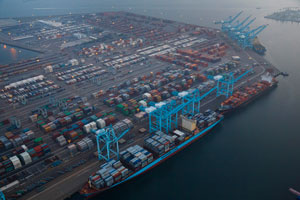Competitors Eating into L.A. Ports' Dominance

Early morning on April 19, the massive Maersk Edmonton moored at the nation's biggest cargo terminal, in the Port of Los Angeles. At 8 a.m., around 200 workers, operating nine cranes, swarmed the 1,200-foot-long containership.
By week's end, continuous shifts of workers had emptied the ship, which carries more than 13,000 container units when fully stocked, onto trucks headed to nearby warehouses or to trains headed across the country.
That seamless choreography is a point of pride for port leaders, who say they've moved past the dysfunction that plagued their business a year ago and are prepared to hold the line against ever more aggressive competitors.
March capped off the busiest first quarter ever for the Port of Los Angeles and the biggest since 2007 for the neighboring Port of Long Beach. Imports at the two ports increased by 10% over the same period last year, as measured by loaded container units.
But ports in other parts of the country, from Houston to New York, have poured money into infrastructure projects to make their coastlines deeper and their terminals more efficient. Now they are slowly eating into the L.A. area's dominance as a gateway to U.S. markets.
In the first three months of 2016, Los Angeles and Long Beach took in 37% of all imports to the country arriving in containers, down from 43% during the same period in 2007.
That shift could accelerate later this year, if an improved Panama Canal opens and siphons business from the West Coast.
"We have witnessed a precipitous drop in market share, based on some things we didn't do well, and ports across the U.S. and Canada did to step up their service capabilities," said Gene Seroka, executive director of the Port of Los Angeles.
New York, the third-largest port in the country, has gained steadily. So have smaller entry points in cities such as Savannah, Georgia, Charleston, South Carolina, and Houston.
"These areas are hungrier. Places that are poor and want to get better are going to try to find a competitive advantage against a place that is richer," said Joel Kotkin, a fellow at Chapman University who has researched the growth of Gulf Coast trade.
The L.A. ports became so congested last year that shipping lines and the companies paying them had to divert their cargo elsewhere.
As talks between dockworkers and shipping companies deadlocked in the fall of 2014, and terminals struggled to handle ever-bigger vessels, ships berthed elsewhere.
Even before the labor dispute peaked, the ports were moving to better coordinate ships, terminals operators, workers and truckers.
They helped make it easier for truckers to access the trailers needed to transport containers. They encouraged shipping companies to load their cargo in Asia methodically, so that dockworkers wouldn't have to spend time separating goods destined for different retailers on the Los Angeles shores.
All the while, the ports invested in technology.
The TraPac terminal, staffed almost entirely by robots, opened in the L.A. port 17 months ago. Today its 28 red cargo-carrying machines hum along, in relative silence, moving containers onto a set of gleaming, self-driving vehicles.
A handful of people participate, often from behind computer screens — directing, say, an automated crane to lower containers onto trucks as they leave the port.
On April 7, the Port of Long Beach received the first ship at its own automated terminal, called Middle Harbor, which is expected to formally open for business later this year. When Middle Harbor is fully built out in 2020, it will be able to handle about half the traffic that moved through the entire port in 2015.
There is little the local ports can do, though, to stem the increased flow of goods to the Southeast.
That region is in the midst of a population boom — Florida, Texas and the coast of the Carolinas are the fastest-growing areas of the country, according to the U.S. Census.
It's also undergoing a manufacturing renaissance. Factory investments include a $1 billion expansion at a BMW plant in South Carolina in 2014 and the opening of an Airbus production facility in Alabama last year.
The influx of cargo to southeast ports "is a function of servicing an industrial market and an expanding population base in the eastern part of the United States," said Jock O'Connell, an international trade economist with Beacon Economics.

